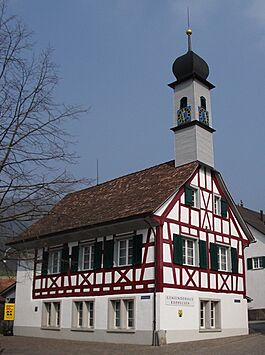Boppelsen facts for kids
Quick facts for kids
Boppelsen
|
||
|---|---|---|
 |
||
|
||
| Country | Switzerland | |
| Canton | Zurich | |
| District | Dielsdorf | |
| Area | ||
| • Total | 3.96 km2 (1.53 sq mi) | |
| Elevation | 521 m (1,709 ft) | |
| Population
(Dec 2020 )
|
||
| • Total | 1,472 | |
| • Density | 371.7/km2 (962.7/sq mi) | |
| Postal code |
8113
|
|
| Surrounded by | Buchs, Otelfingen, Regensberg, Schleinikon | |
Boppelsen is a municipality in the district of Dielsdorf in the canton of Zürich in Switzerland.
Contents
History
Boppelsen is first mentioned in 1130 as de Bobpinsolo.
Geography
Boppelsen has an area of 3.9 km2 (1.5 sq mi). Of this area, 42.6% is used for agricultural purposes, while 47.4% is forested. Of the rest of the land, 9.7% is settled (buildings or roads) and the remainder (0.3%) is non-productive (rivers, glaciers or mountains).
The municipality is located in the hills above the Furttal.
Demographics
Boppelsen has a population (as of 31 December 2020) of 1,472. As of 2007[update], 11.2% of the population was made up of foreign nationals. Over the last 10 years the population has grown at a rate of 41.7%. Most of the population (as of 2000[update]) speaks German (92.2%), with Portuguese being second most common ( 2.7%) and French being third ( 0.7%).
In the 2007 election the most popular party was the SVP which received 39.8% of the vote. The next three most popular parties were the FDP (16.9%), the CSP (15.1%) and the SPS (10.3%).
The age distribution of the population (as of 2000[update]) is children and teenagers (0–19 years old) make up 21.6% of the population, while adults (20–64 years old) make up 68.4% and seniors (over 64 years old) make up 10%. About 87.8% of the population (between age 25-64) have completed either non-mandatory upper secondary education or additional higher education (either university or a Fachhochschule).
Boppelsen has an unemployment rate of 1.44%. As of 2005[update], there were 112 people employed in the primary economic sector and about 17 businesses involved in this sector. 21 people are employed in the secondary sector and there are 8 businesses in this sector. 82 people are employed in the tertiary sector, with 31 businesses in this sector. The historical population is given in the following table:
| year | population |
|---|---|
| 1634 | 168 |
| 1709 | 206 |
| 1850 | 334 |
| 1900 | 256 |
| 1910 | 234 |
| 1950 | 292 |
| 2000 | 1,018 |
See also
 In Spanish: Boppelsen para niños
In Spanish: Boppelsen para niños





